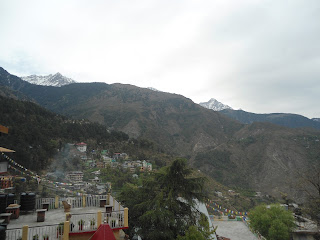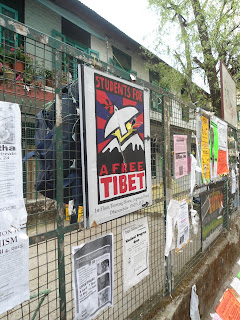The first thing I noticed when I got out of Heathrow airport
was how green everything is. There are green things in Delhi, of course there
are. But not like this. Not the brilliant green shimmering in the sun that can
only be the result of regular rainfall. Beyond the initial shock at how green
everything is there is the realisation of how quiet it is. Travelling down the
motorway in a National Express coach I am bewildered by this silence. Silence
you can hear. Silence that shouts above anything else. Have I gone deaf? Where
has the honking gone? All banished from this sanitised world that I have craved
for so long, but now I wonder whether it is what I want after all.
Heathrow Airport seemed empty compared to Delhi. Yes I know,
one of the busiest airports in the world. But eerily empty compared to the
Delhi Metro on return from work. So much personal space, but what to do with
it? The little train through the airport has room for people to sit in. But people
don’t sit next to each other if they can avoid it. The airport is so clean, so
ordered, sanitised. Rules, regulations must not be broken. No pushing or
shoving in the queue here. Driving out the bus goes in a straight line. No
weaving between the traffic. No undertaking. Of course that is a good thing, but
just so different from the last four months.
I have not just travelled to a different country, but to a
different world. A world where the air is so clean it is invigorating. A world
where things work when you want them to. Where the coach departs from the time
and place advertised. Where old ladies complain about a three hour journey in a
coach. But I did not have the heart to explain that I had left my hotel
seventeen hours previously. Why spoil her fun when she is enjoying telling
people about what she has endured?
The Isle of Wight has not changed. Of course it hasn’t. It
hasn’t really changed in decades. The odd thing has altered. Fibre optic
broadband has arrived. I’m told this is amazing. That films can be downloaded
in minutes, not hours. But the island will remain the same no matter what
technology changes around it. But maybe the way I see it is different. Spending
time in India changes the way you see everything. Even as I wanted to go home,
India had got inside me, moulding me so that I’ll never see my island in the
same way again, making a nest for itself so I can never be rid of it. Not that
I’d want to.
Being home is so normal that it is hard to imagine that
somewhere, in a parallel universe, the chaos of Delhi is still going on. Rickshaws
are still frantically weaving through the traffic. Traders are shouting above
the crowds in Nehru Place, trying to sell ‘software, software’ that nobody
wants. The smell from the nearby sewage works is drifting over an illegal hotel.
Contacting those that
are still there feels like I’m breaking some unwritten law of the universe. I’ve
gone back through the wardrobe and that route back to Narnia should have closed
itself off. Of course it hasn’t, but how do you explain to those that have not
experienced what is on the other side of the wardrobe? Pictures, videos and
stories – they just don’t do it justice. Most don’t really want to hear anyway.
They ask out of kindness, but would much rather talk about new road works, the disastrous
results of island schools or Jose Mourinho’s return to Chelsea.
At the weekend I went to Birmingham to watch a cricket
match. On the way from the station to my hotel I tried to haggle with the taxi
driver. He was quite offended. ‘It will be on the metre’- rules, regulations
will not be broken. No negotiation. This will take some getting used to. The
bus to the centre of Birmingham would not give change. Just like Delhi, change
becomes the most valuable thing in the world. My wallet was still filled with rupee
coins. I made up the change with two rupee coins pretending to pennies. The
pretence was a success, but it could not possibly be over a period of time. Some
might consider that a metaphor there for my time in India. But did I really try
hard enough to pretend to fit in anyway?
Cricket in England is so different to the rock concert
atmosphere of the IPL in Delhi. Ferocious cheering was replaced with a gentle
clapping in appreciation of a fine shot. The cheerleaders who so caught the
attention of the gawking men of Delhi replaced by Beefeaters sweltering in
ceremonial gear with drums. With the
match beamed into a bar in Hauz Kaus one of my fellow interns said they thought
of me in the stand. Those two worlds together, the planets aligned, just for a
few moments.
Of course I am pleased to be back. If there is one thing
India has taught me, it is to appreciate what is good in the UK. I can now walk
outside without sweating and no longer have to worry about keeping water in the
fridge because it is too hot to drink from the tap. But to a certain extent I
feel some affinity with those returning back from a war zone. It just feels so
normal here, while I know the battle still rages in Delhi. I’ve heard that my
fellow interns have been banned from the nearby swimming pool. No foreigners
allowed. There are power cuts through
the night which make it impossible to sleep. Evidently they were up at 3am with
their feet dipped in buckets of water so as to make it bearable. The battle
continues, but I’m no longer part of it.
































